
The Arcida is an extant order of bivalve molluscs. This order dates back to the lower Ordovician period. They are distinguished from related groups, such as the mussels, by having a straight hinge to the shells, and the adductor muscles being of equal size. The duplivincular ligament, taxodont dentition, and a shell microstructure consisting of the outer crossed lamellar and inner complex crossed lamellar layers are defining characters of this order.
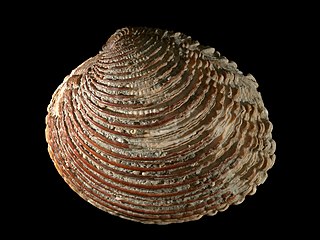
The Veneridae or venerids, common name: Venus clams, are a very large family of minute to large, saltwater clams, marine bivalve molluscs. Over 500 living species of venerid bivalves are known, most of which are edible, and many of which are exploited as food sources.
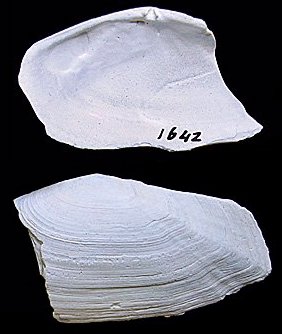
The Psammobiidae, or sunset clams, are a family of medium-sized saltwater clams, marine bivalve molluscs of the order Cardiida.

Nuculidae is a family of small saltwater clams in the order Nuculida. Species in this family are commonly known as nut clams.

Mactridae, common name the trough shells or duck clams, is a family of saltwater clams, marine bivalve mollusks in the order Venerida.

Tridacna crocea, the boring clam, crocus clam, crocea clam or saffron-coloured clam, is a species of bivalve in the family Cardiidae. It is native to the Indo-Pacific region. It is occasionally found in the aquarium trade where it is often simply referred to as crocea.
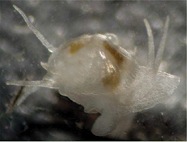
Galeommatidae is a family of small and very small saltwater clams, marine bivalve molluscs in the order Galeommatida.

Lucinidae, common name hatchet shells, is a family of saltwater clams, marine bivalve molluscs.

Crassatellidae is a family of small saltwater clams, marine bivalve molluscs of the order Carditida.

Verticordiidae is a family of benthic marine bivalves in the superorder Anomalodesmata. These clams range from 2 - 200 millimeters in length and are mainly found in coastal waters surrounding Australia and the Americas, though a few species within this family such as Haliris mediopacifica are found in the middle of the ocean. Verticordiidae is known for being a family of septibranchs, or predatory bivalves, rather than filter feeders. Clams dig vertical burrows in substrate and use papillae around the edges of their inhalant siphons to detect microscopic prey. Some clams in this family, specifically in the genus Trigonulina, have distinct extended circular formations on their shells.
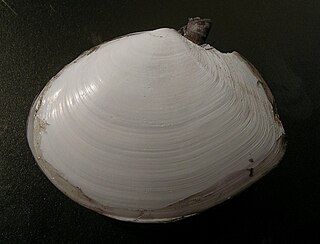
Macoma is a large genus of saltwater clams, marine bivalve molluscs in the family Tellinidae, the tellins.
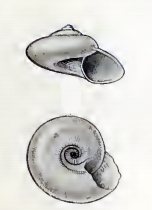
Solariellidae is a family of small sea snails, marine gastropod mollusks in the superfamily Trochoidea.

Sinum is a genus of predatory sea snails, marine gastropod mollusks in the subfamily Sininae of the family Naticidae, the moon snails.
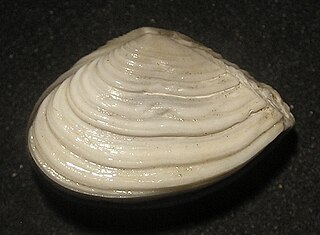
Corbula is a genus of very small saltwater clams, marine bivalve molluscs in the family Corbulidae, the basket clams.
Solemya velum, the Atlantic awning clam, is a species of marine bivalve mollusc in the family Solemyidae, the awning clams. This species is found along the eastern coast of North America, from Nova Scotia to Florida and inhabits subtidal sediments with high organic matter (OM) content and low Oxygen, such as salt ponds, salt marshes, and sewage outfalls.

Periglypta is a genus of bivalves in the subfamily Venerinae of the family Veneridae.
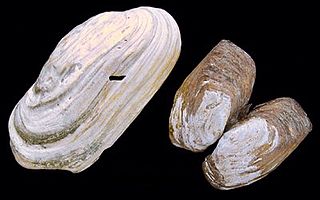
Hiatella is a genus of small saltwater clams, marine bivalve molluscs in the family Hiatellidae.

In May 2010, a new taxonomy of the Bivalvia was published in the journal Malacologia. The 2010 taxonomy is known as the Taxonomy of the Bivalvia . The 2010 taxonomy was published as Nomenclator of Bivalve Families with a Classification of Bivalve Families. This was a revised system for classifying bivalve mollusks such as clams, oysters, scallops, mussels and so on. In compiling this new taxonomy, the authors used a variety of phylogenetic information including molecular analysis, anatomical analysis, shell morphology and shell microstructure, as well as bio-geographic, paleobiogeographical and stratigraphic information.

Solemya elarraichensis is a species of marine bivalve mollusc in the family Solemyidae. It is endemic to the deep-water mud volcano slopes in the Gulf of Cadiz in the eastern Atlantic Ocean.

Solemya is a genus of saltwater clams, marine bivalve mollusks in the family Solemyidae, the awning clams. Solemya is the type genus of the family Solemyidae.


















